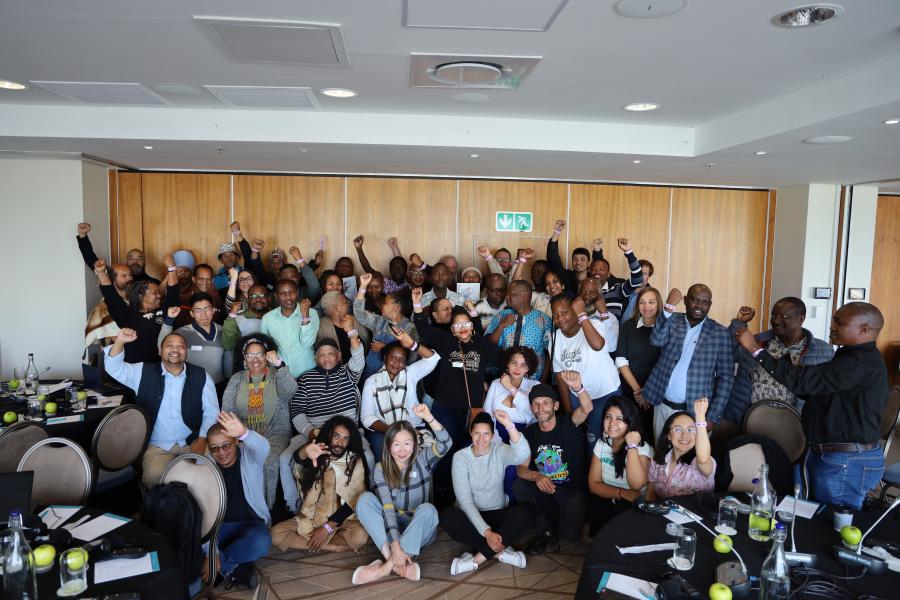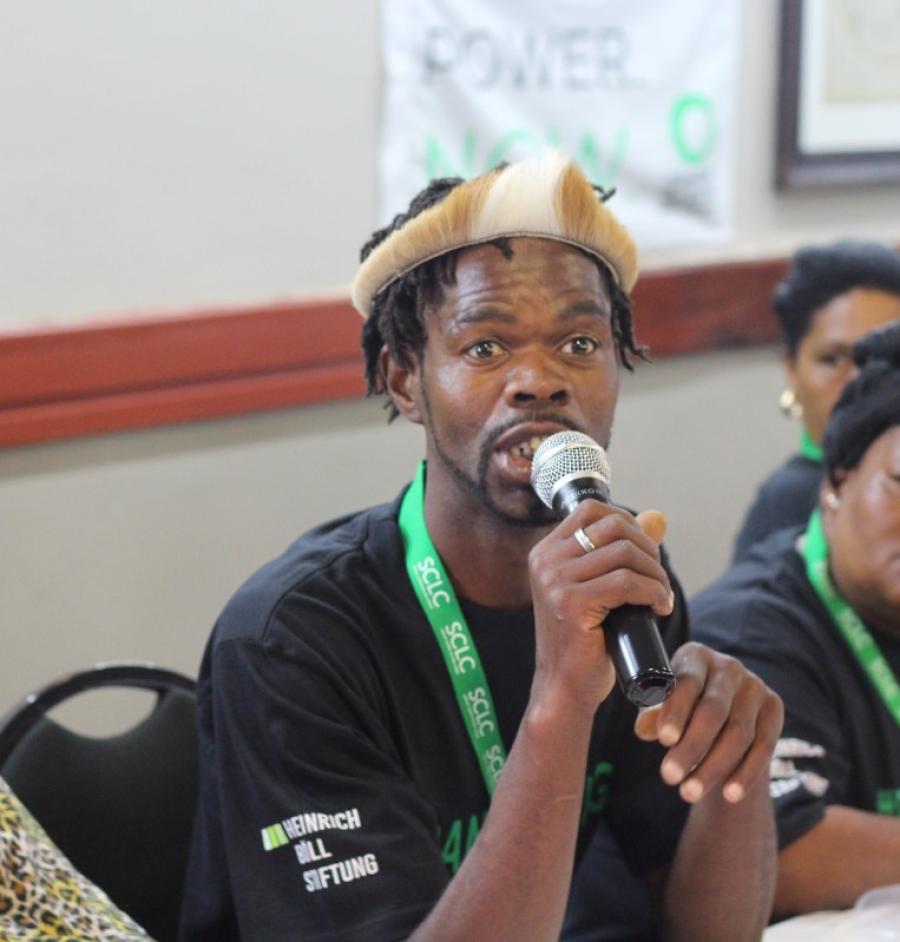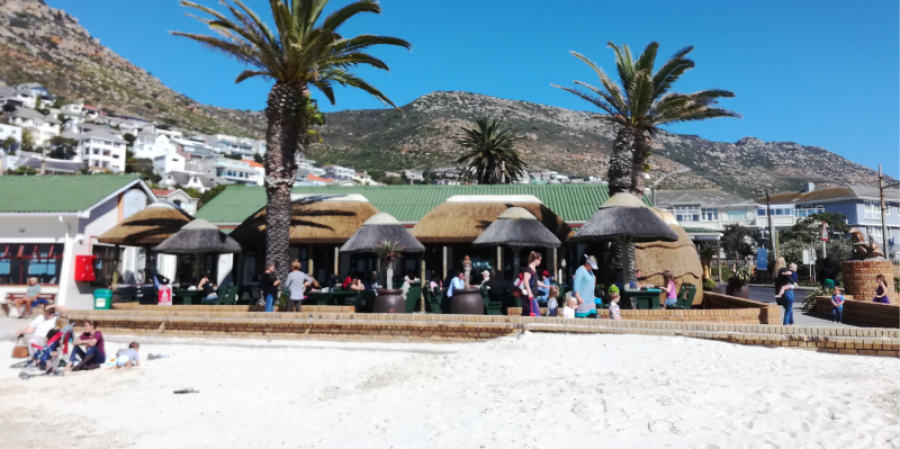|Una: I think those are sheep (|uru) over there.Kheis: What? You are not only old, you are blind! Aenki: We all see stones (||uru) and you see sheep (|uru). Andries: Where are there sheep, |Una? You are blind. There are only rocks (!ao). Farmers don’t raise rocks (!ao).
78-year-old |Una Rooi giggles like a girl at the aspersions being cast on her eyesight by her relatives. The mini-bus fills with laughter as we bump along yet another dirt road under the endless blue sky of Northern Cape Province in South Africa.
There is nothing unusual about this exchange other than that it is conducted in the N|u language, South Africa’s oldest surviving language, spoken by only 20 people. The occasion is remarkable for me as it is the first time I manage to follow a N|u conversation and laugh along with the joke. The elders are playing on the similarity of the words for sheep and quartzite rocks.
A week after |Una’s teasing, Johanna Koper visits Annie Koerant. Johanna is fulsome in body and robust in humor. Annie is lean and poker-faced, and gives off a stern air. They live under similar conditions of poverty in small cement township houses almost 200 kilometres apart. Both women are 80 years old. Annie is tending her daughter, who is dying of tuberculosis. In a room full of people, only Annie’s daughter and I can understand snatches of the rapid conversation between the elderly N|u speakers. They are laughing, catching up on news, acknowledging the hardness of life, and talking about the good old days.
School children and unemployed neighbors stare open-mouthed, listening to the rapid succession of clicks, deep pharyngeal vowels, glottal stops, and other complex sounds of this ancient tongue. Johanna switches back into Afrikaans to address the house full of onlookers: "What are you staring at? None of you understand our language! Listen, I love my language. It is too good to leave to you. You only speak Afrikaans." Sheepish looks and shy smiles go round.
N|u is the last of the !Ui languages of South Africa and these are its last speakers. It was thought that the last speaker died out in the 1970s (Traill, 1995), but during the process of organizing a land-claim with the ‡Khomani people in 1997, the South African San Institute (SASI) discovered one N|u speaker, a venerable great-grandmother living in the dusty village of Rietfontein on the southern edge of the Kalahari Desert. One of the world’s specialists in !Ui-Taa languages flew out to interview her. Professor Anthony Traill played recordings from the 1930s made at Twee Rivieren and in Johannesburg. Elsie Vaalbooi, approximately 102 years old at the time, listened attentively and started to translate them back.
Elsie’s son Petrus, who cannot speak his mother’s language, made it his personal mission to look for other N|u speakers. For him, the restoration of the language was as important as the restoration of their lands. Within a few months, another two speakers were found in Upington, a major town on the Orange River (called ‡Ari or |Kxen in N|u).
With the support of SASI, 25 elders were rediscovered over the following four years. Using archival photographs and genealogies, the elders were able to work out how they are related. They began to share their hidden history with the rest of their communities. The old people had hidden their Bushman or San identity in an attempt to lessen the stigma they’d endured. An element of this survival strategy was to smother their language and promote fluency in Afrikaans amongst their children. In 1997, many of the young people had no idea they were of aboriginal descent and had never heard N|u spoken.
Magdalena Kassie, the daughter of N|u speaker Aenki Kassie, now spearheads a movement to locate displaced elders and motivate young people to learn the ancient tongue. Namibian linguist Levi Namaseb has played a valuable role in creating an alphabet for the phonetically complex language and in teaching it to interested young people. SASI runs a program on cultural heritage and cultural resource management that includes helping young people learn bushcraft, history, genealogy, mythology, and ethno-ecology. SASI is assisted by anthropologist and activist Hugh Brody, who had extensive experience working with displaced First Nations groups in Canada, and in territorial mapping by Bill Kemp of Strata 360 in Canada.
Part of the challenge for southern Kalahari San has been to figure out who they are. Their oral history has been fractured by their dispossession. Through reviving oral history and reviewing archival literature, the San people have come to understand the roots of their identity and their current situation. In 1911, the intrepid Dorothea Bleek traveled through the southern Kalahari and was the first to record the N|u language. She identified it with two different groups of people, the N||n in the east, and the people called ‡Khomani in the west. These peoples constitute only one language and ethnic group. They call themselves N||n‡e (home people), and speak N|u (our language).
A second round of ethnographic and linguistic research was conducted in 1936 by a distinguished team of researchers from the University of Witwatersrand. Their purpose was to determine if the people living in territory that had just been declared a national park were in fact aboriginal San. In the concepts of the time, the issue was about racial purity. The San elders and youths submitted to having their heads and bodies measured and cast, including detailed measurements of their genitalia. The "evidence" was written up by Professor Raymond Dart, but had little effect on securing rights for the San.
Most of the 77 San put on exhibition in Johannesburg in 1936 were never allowed to return home. Instead, the park’s new warden brought in other San to work as laborers. These families were able to continue hunting and gathering throughout the 1940s and into the 1950s, but as the Apartheid policy took hold in South Africa, the San found their rights and the quality of their lives increasingly eroded. By the 1970s, the relationship between the San and the national park had become embittered and intolerable. According to San elders, they were summarily expelled from the park when they complained to tourists about their treatment.
For the next 20 years, the various dispossessed San of the southern Kalahari did what they could to survive. Their languages were suppressed, partly on their own initiative, to protect their children from victimization. They worked as sheep shearers, farm laborers, gardeners, or ditch diggers. Their neighbors rarely knew of their aboriginal identity and some did not even reveal it to their children.
The San expelled from the Park continued to live off their image as "traditional Bushmen," working at a series of tourist resorts. It was there that lawyer Roger Chennells came in contact with them in 1995. Chennells realized that the San had the right to apply for restitution of their lands under South Africa’s new post-Apartheid constitution (see page 51).
The families initiated a land claim against their forced removal from Kalahari Gemsbok National Park. It was a daring move, as they might have to prove once again their aboriginal identity and their displacement on the grounds of race, a difficult proposition in light of their fractured oral history and near-dead language.
SASI worked to help the San register their community for the claim. The group at first thought that there were only about 50 adults, but within a few months, more than 300 registered. Current estimates put the community at about 1000 people. All of them had become invisible and silent for 40 years of diaspora and suppression. But their roots were still alive.
With the assistance of the elders and their knowledge of the land, their claim was successful. In March 1999, the Government of South Africa awarded the southern Kalahari San 40,000 hectares of land outside the national park, and further 25,000 inside the park.
Language and Identity
It is impossible to talk about language and identity in South Africa without getting tangled up in the sticky web of race and identity. The genealogical research among N||n‡e elders proved that "racial" purity was never what the European settlers would have liked it to be. Griquas married Bakgalakgadi, Namas married Basters, and European men had children illicitly with San women. Nonetheless, language played an important role in identity, and as waves of settlers entered, "race," language, and identity became markers of power and powerlessness.
Some San even opposed the land claim, buying into old beliefs that the San identity is primitive and humiliating. But others took the opposite view. With a resurgence of pride in their identity, San youth and leaders began to debate exactly what it means to be San in the 21st century. For Petrus, Magdalena, and others in the community, the past few years have been a period of rediscovery and of profound changes in their sense of self and of the identity of their community.
The word "Bushman" has been partly rehabilitated, the word "San" is gaining currency among young people, and N|u has become an emblem of their aboriginality and authenticity. Many people choose to refer to themselves as ‡Khomani or Khomani, with as many pronunciations of the term as there are understandings of what it means.
After a week-long N|u course given by Namaseb, we took advantage of the occasion to teach some history to the younger people, who had all studied the San in high school history classes but did not link their studies to their own families. They were visibly shaken to realize the significance of the N|u language. They could understand for the first time that they were in fact the First People of South Africa. Magdalena described her feelings, "It is like I have been in the dark all this time. Suddenly I can understand what is going on. It makes sense now. I can see for the first time."
Six months later, Magdalena and her mother, Aenki, jetted off to Paris as guests of UNESCO to give a presentation on the heritage management project they have initiated with SASI’s technical and financial support.
Meanwhile, when the few N|u speakers gather, it isn’t long before they slip into a favorite activity: recounting stories of characters from the early days of the 20th century. Johanna Koper loves to create a cast of characters using different voices to show the weak, the aggressive, the foolish, the naïve, and the victims. Her cousins and distant relatives who understand her tongue laugh uproariously, shouting approval, adding details to the story, and shouting out in chorus: kx’make! Kx’make! (It is true! It is true!) For them, it is up to the next generation to prove that it is worthy of inheriting the last !Ui language.
For more information on language revitalization programs, see CSQ 25:2, Endangered Languages, Endangered Lives.
A version of this article will appear in Finlayson et al. Eds. Language and Identity. To be published in the Curzon African Linguistic Series (CALS) in 2002.
References & further reading
Bleek D.F. (1911). Field notes from 1911 trips to Griqualand and Gordonia expeditions. Notebooks 2 and 3. Housed at the Rare Documents and Manuscripts Department, University of Cape Town.
Bleek, D.F., edited and introduced by Tom Güldemann (2000). The ||N!ke or Bushmen of Griqualand West. Notes on the language of the ||N!ke or Bushmen of Griqualand West. Khoisan Forum, Working Paper 15. Köln: Institut für Afrikanistik, Universität zu Köln.
Dart, R. (1937). Hut Distribution, Genealogy and Homogeneity of the |’Auni - ‡Khomani Bushmen. In Rheinallt-Jones J.D. & C.M. Doke, Eds. (1937). Bushmen of the Southern Kalahari. Johannesburg: Witwatersrand University Press.
Department of Linguistics (1997). Extinct: South African Khoisan Languages. Compact Disc. Johannesburg: University of the Witwatersrand.
Elphick, R. (1977). Kraal and Castle: Khoikhoi and the founding of white South Africa. New Haven: Yale University Press.
Mesthrie, R., Ed. (1995). Language and Social History: Studies in South African Sociolinguistics. Cape Town: David Philip.
Rheinallt-Jones J.D. & C.M. Doke, Eds. (1937). Bushmen of the Southern Kalahari. Johannesburg: Witwatersrand University Press.
Traill, A. (1995). The Khoesan languages of South Africa. In Mesthrie, R., Ed. (1995). Language and Social History: Studies in South African Sociolinguistics. Cape Town: David Philip.
Traill, A. (1996). !Khwa-Ka Hhouiten Hhouiten, “The Rush of the Storm”: The Linguistic Death of |Xam. In P. Skotnes (1996). Miscast: Negotiating the Presence of the Bushmen. Cape Town: UCT Press.



